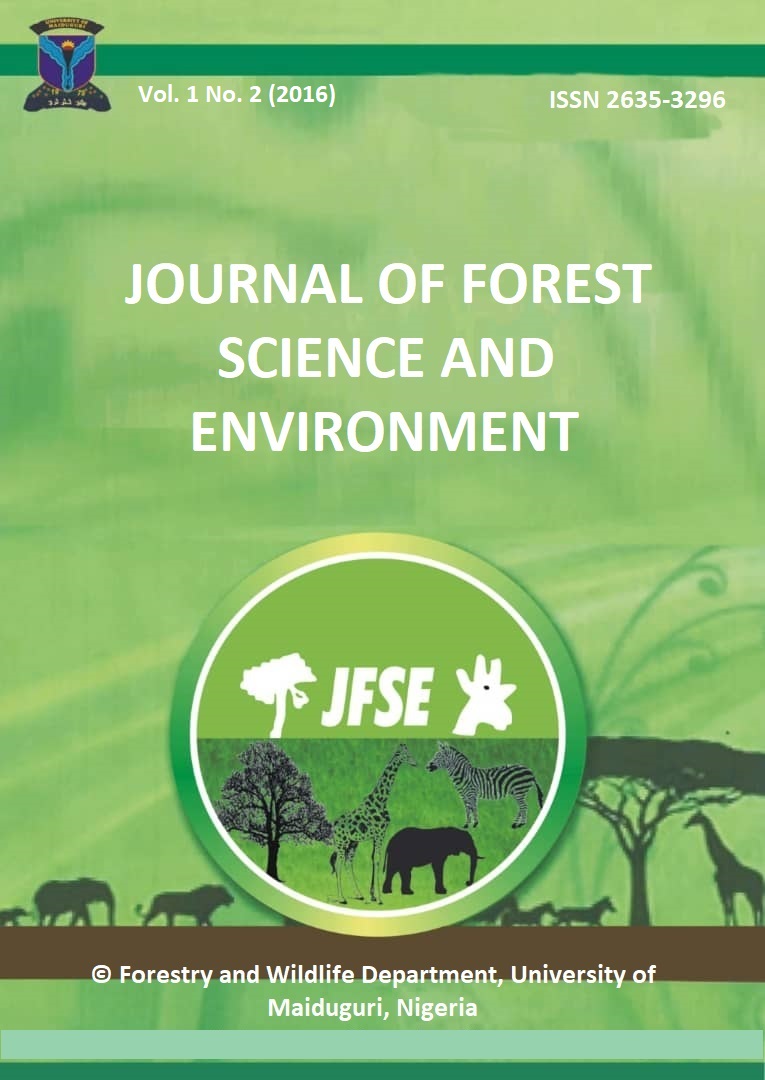Abstract
Non -Timber Forest Products (NTFPs) gathered for food, medicine, craft, spiritual and
aesthetic purposes make substantial contributions to the economic viability and cultural vitality of communities. This study examined the prioritization of Non- Timber Forest Products (NTFPs) and poverty reduction in Ido local government area of Oyo State. Primary data were collected using a structured questionnaire administered to ninety respondents Multistage sampling technique was used. The rural settlement consists of 7 zones out of which 3 zones were selected. Three villages were selected
from the 3 zones and 10 respondents were randomly selected from each. The villages include Erinwusi, Lagbin, Bakatari, Oderemi, Mowunni, Abata, Ido, Akerele and Baale-Sango. Data collected were analyzed with descriptive and inferential statistics. Econometric tool of Income Level Approach and Gini index were used to determine poverty line and the significance of NTFPs in the welfare of the respondents respectively. Smith’s saliency (S) was used to identify the prioritized NTFPs. Respondents perception was measured with Likert scale rating. The results revealed that majority, (61.1%) were male and (38.9%) were female. This implies gender sensitive activities. Educationally, most of the respondents have no formal education (46.7%). On income, 26% have major income of N15,100 - N25,000, also 53.1% have a minor income of ≤ N10,000. Poverty line ofN19,630 was determined,
poverty incidence (Po) estimated was 24.4% which means 22 respondents fell below the poverty line while 75.6% were above the poverty line, Also, poverty depth (P1) showed that an average person requires 5.24% of N 19,630 to reach the poverty line. Poverty severity (P2), 0.2 indicates that the people were not severely poor. The Smith saliency (S) also showed Dongoyaro (Azadirachta indica) as the most prioritized plant species and Snail Archachatina marginata for animals in the study area. The Gini index revealed that the major income (0.003) had effect on income inequality than minor income (0.005) among the respondents. The total Gini index of the respondents was (0.004). Suggestions include forest policy should promote sustainable exploitation of NTFPs among rural and forest dependent communities through eco –incentives and appropriate conservation measures.
References
Falconer J (1997). Developing Research Frames for Non-Timber Forest Products: Experience from Ghana: In: M Ruiz Pérez, JEM Arnold (eds.): Current Issues in Non-timber Forest Products Research. Bogor, Indonesia: Centre for International Forestry Research, Pp. 143-160.
FAO (1990). Survey of Tropical Forest cover and study of change processes. FAO Forestry paper No. 130, Rome, Italy
FAO (1995). Non wood Forest Products in Forestry. Forestry education, new trends and prospects. FAO Forestry paper No123, Rome, Italy
FAO (1995). Non wood Forest Products for Rural Income and Sustainable Forestry. Food Agriculture Organisation. United Nations, Rome 7:4-9.
FAO (2005). The State of Food Insecurity in the World:Eradicating World Hunger Key to Achieving the Millennium Development Goals. Food and Agriculture Organisation, Rome, Italy.
FAO (2015). Global Forest Resources Assessment 2015: How are the world’s forests changing? FAO Forestry paper No , Rome, Italy.
FOS (1996). Annual Abstract of Statistics. Federal Office of Statisics, Lagos, Nigeria. 1996 edition, 462p
Foster J, Greer J, and Thorbecke E (1984). A class of decomposable poverty measures. Econometrica 52 (3): 761-766
Jimoh SO (2002). A multiple-use planning model for tropical rain forests: The case of Shasha Forest Reserve, Osun State Nigeria Ph.D. Thesis, Department of Forest Resources Management, University of Ibadan, Nigeria. pp: 253.
Lawes M, Eeley H, Shacleton, CM and Geach BS (2004). Indigenous Forests and Woodland in South Africa: Policy People and Practice. Pietermaritzburg: University of kwazulu- Natal Press.
NBS (2006). Annual Abstract of Statisics. National Bureau of Statistics, Abuja, Nigeria
Olsen CS (1998).The trade in medicinal and aromatic plants from central Nepal to northern India. Economic Botany. 52(3): 279-292.
Ogle B (1996). Peoples’ dependency on forests for food security: some lessons learned from programme of case studies: In. Ruiz-Perez M and Arnold JEM (eds.). Current issues on non timber forest products research. CIFOR, Bogor. Pp 219-242
Ransome-Kuti O (1991). Introduction (pp: x-xiv) In: Ransome-Kuti, O. A. O. O. Somurewa, K.S. Oyegbile and A. Bamisaye (Eds.). Strengthening Primary Healthcare at Local government Level-The Nigerian Experience, Pp 135.
Roderick PN, and Eric H (2000). Commercialization of Non-Timber Forest Products: Review and Analysis of Research. Centre for International Forest Research.23-25.
Sen AK (1980). Poverty elimination and entitlements: Policy and change. World Bank Staff Reoport No 401, July 1980. Washington, D.C. The World Bank.
Schumacher EF (1973). Small is beautiful. Economics as if people mattered. Harper Torch Books, London. 289p
Sunderland TCH, Harrison ST, and Ndoye O (2004). Commercialisation of non-timber forest products in Africa: history, context and prospects. In: Sunderland, T.C.H. and Ndoye, O. (eds.). Forest products, livelihoods and conservation: case studies on non-timber forest product systems. volume 2 - Africa: 1-24. CIFOR, Bogor, Indonesia.
UNDP (2004). The Equator Initiative: Money Grows on Trees. Cameroon Series 5, New York: UNDP.
Wickens GE (1991). Management issues for Development of non-timber forest products. Unasylva, 42(165):3-8.


